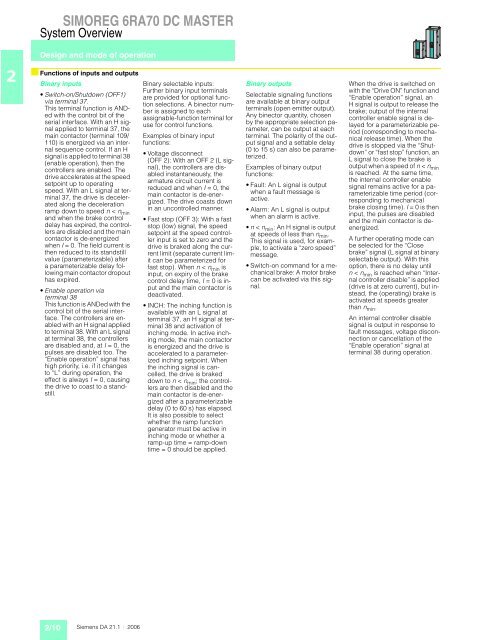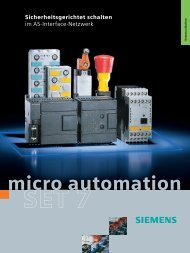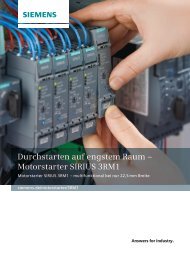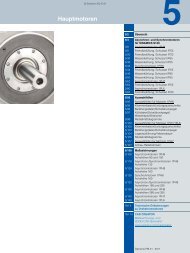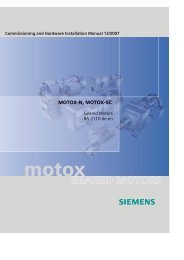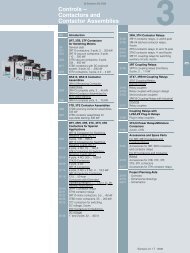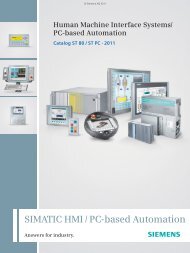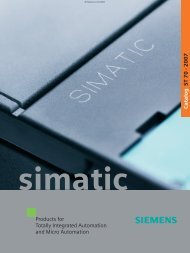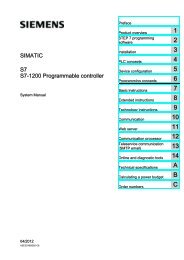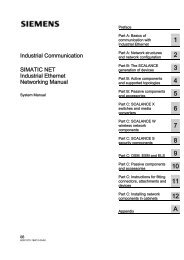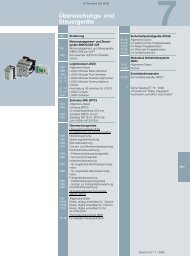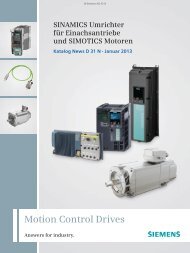simoreg 6ra70 dc master
simoreg 6ra70 dc master
simoreg 6ra70 dc master
You also want an ePaper? Increase the reach of your titles
YUMPU automatically turns print PDFs into web optimized ePapers that Google loves.
2<br />
SIMOREG 6RA70 DC MASTER<br />
System Overview<br />
Design and mode of operation<br />
■ Functions of inputs and outputs<br />
Binary inputs<br />
Switch-on/Shutdown (OFF1)<br />
via terminal 37.<br />
This terminal function is ANDed<br />
with the control bit of the<br />
serial interface. With an H signal<br />
applied to terminal 37, the<br />
main contactor (terminal 109/<br />
110) is energized via an internal<br />
sequence control. If an H<br />
signal is applied to terminal 38<br />
(enable operation), then the<br />
controllers are enabled. The<br />
drive accelerates at the speed<br />
setpoint up to operating<br />
speed. With an L signal at terminal<br />
37, the drive is decelerated<br />
along the deceleration<br />
ramp down to speed n < n min<br />
and when the brake control<br />
delay has expired, the controllers<br />
are disabled and the main<br />
contactor is de-energized<br />
when I = 0. The field current is<br />
then reduced to its standstill<br />
value (parameterizable) after<br />
a parameterizable delay following<br />
main contactor dropout<br />
has expired.<br />
Enable operation via<br />
terminal 38<br />
This function is ANDed with the<br />
control bit of the serial interface.<br />
The controllers are enabled<br />
with an H signal applied<br />
to terminal 38. With an L signal<br />
at terminal 38, the controllers<br />
are disabled and, at I = 0, the<br />
pulses are disabled too. The<br />
“Enable operation” signal has<br />
high priority, i.e. if it changes<br />
to “L” during operation, the<br />
effect is always I = 0, causing<br />
the drive to coast to a standstill.<br />
2/10<br />
Siemens DA 21.1 · 2006<br />
Binary selectable inputs:<br />
Further binary input terminals<br />
are provided for optional function<br />
selections. A binector number<br />
is assigned to each<br />
assignable-function terminal for<br />
use for control functions.<br />
Examples of binary input<br />
functions:<br />
Voltage disconnect<br />
(OFF 2): With an OFF 2 (L signal),<br />
the controllers are disabled<br />
instantaneously, the<br />
armature circuit current is<br />
reduced and when I = 0, the<br />
main contactor is de-energized.<br />
The drive coasts down<br />
in an uncontrolled manner.<br />
Fast stop (OFF 3): With a fast<br />
stop (low) signal, the speed<br />
setpoint at the speed controller<br />
input is set to zero and the<br />
drive is braked along the current<br />
limit (separate current limit<br />
can be parameterized for<br />
fast stop). When n < nmin is<br />
input, on expiry of the brake<br />
control delay time, I = 0 is input<br />
and the main contactor is<br />
deactivated.<br />
INCH: The inching function is<br />
available with an L signal at<br />
terminal 37, an H signal at terminal<br />
38 and activation of<br />
inching mode. In active inching<br />
mode, the main contactor<br />
is energized and the drive is<br />
accelerated to a parameterized<br />
inching setpoint. When<br />
the inching signal is cancelled,<br />
the drive is braked<br />
down to n < nmin; the controllers<br />
are then disabled and the<br />
main contactor is de-energized<br />
after a parameterizable<br />
delay (0 to 60 s) has elapsed.<br />
It is also possible to select<br />
whether the ramp function<br />
generator must be active in<br />
inching mode or whether a<br />
ramp-up time = ramp-down<br />
time = 0 should be applied.<br />
Binary outputs<br />
Selectable signaling functions<br />
are available at binary output<br />
terminals (open emitter output).<br />
Any binector quantity, chosen<br />
by the appropriate selection parameter,<br />
can be output at each<br />
terminal. The polarity of the output<br />
signal and a settable delay<br />
(0 to 15 s) can also be parameterized.<br />
Examples of binary output<br />
functions:<br />
Fault: An L signal is output<br />
when a fault message is<br />
active.<br />
Alarm: An L signal is output<br />
when an alarm is active.<br />
n < nmin : An H signal is output<br />
at speeds of less than nmin. This signal is used, for example,<br />
to activate a “zero speed”<br />
message.<br />
Switch-on command for a mechanical<br />
brake: A motor brake<br />
can be activated via this signal.<br />
When the drive is switched on<br />
with the “Drive ON” function and<br />
“Enable operation” signal, an<br />
H signal is output to release the<br />
brake; output of the internal<br />
controller enable signal is delayed<br />
for a parameterizable period<br />
(corresponding to mechanical<br />
release time). When the<br />
drive is stopped via the “Shutdown”<br />
or “fast stop” function, an<br />
L signal to close the brake is<br />
output when a speed of n < nmin is reached. At the same time,<br />
the internal controller enable<br />
signal remains active for a parameterizable<br />
time period (corresponding<br />
to mechanical<br />
brake closing time). I = 0 is then<br />
input, the pulses are disabled<br />
and the main contactor is deenergized.<br />
A further operating mode can<br />
be selected for the “Close<br />
brake” signal (L signal at binary<br />
selectable output). With this<br />
option, there is no delay until<br />
n < nmin is reached when “Internal<br />
controller disable” is applied<br />
(drive is at zero current), but instead,<br />
the (operating) brake is<br />
activated at speeds greater<br />
than nmin .<br />
An internal controller disable<br />
signal is output in response to<br />
fault messages, voltage disconnection<br />
or cancellation of the<br />
“Enable operation” signal at<br />
terminal 38 during operation.


